21 February 2024
Legacy of Liberation: Big Week and the fight for Allied air supremacy over Europe
80 years ago this week, Germany’s skies were filled with Allied aircraft as Big Week broke. Discover the story of the RAF’s role in this important step in the liberation of Europe.
Big Week
Lancaster JB610
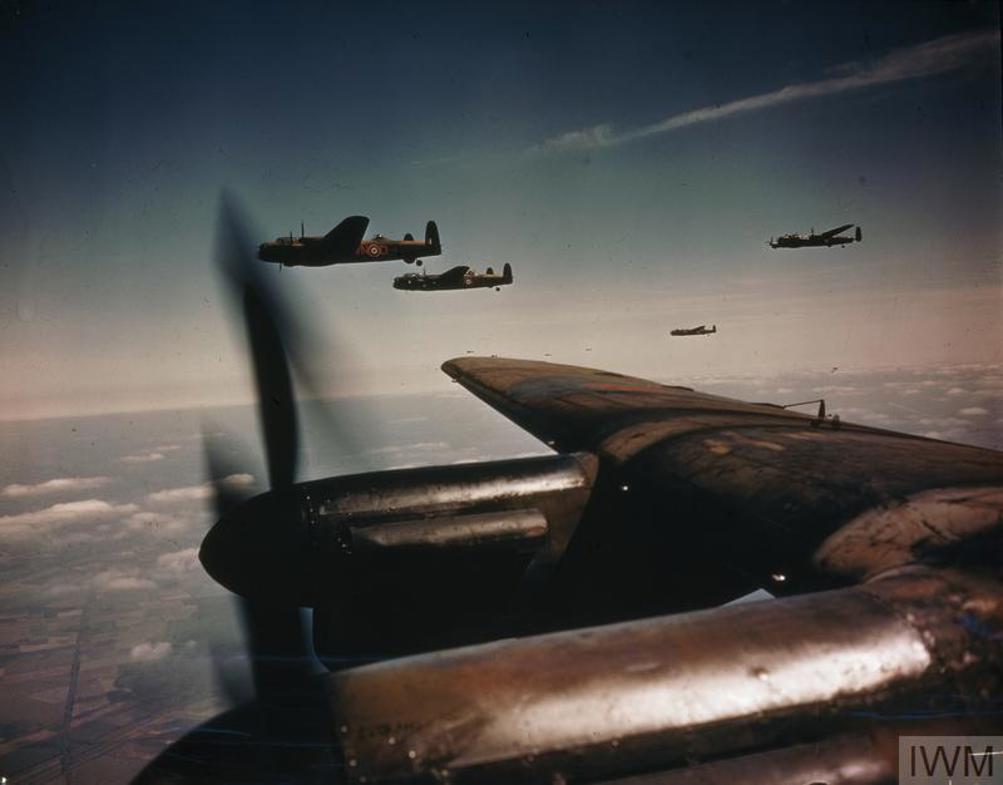
Image: Lancaster bombers in the skies over Europe (© IWM TR 1156)
The mixed Australian/British crew of Lancaster JB610 were no strangers to trouble while airborne.
On the night of December 16/17, 1943, in their old Lancaster JB704, they had nursed their craft back to Berlin and back, before crash landing in heavy fog on their landing back home. While JB704 was wrecked, all her crew survived.
At 23:34 on the evening of February 19, 1944, JB610 took off from RAF Binbrook in Lincolnshire. Their target was Leipzig, a major centre of German industry.
At her controls were Pilot Officer Ken Godwin with Flying Officer John Morris, Flight Sergeants Frank Hennessey and Vernon Dellit, and Sergeants Michael Wiggins, Cyril Wood and Frank Clarkson making up JB610’s crew.
JB610 and her crew were one of 24 Lancasters of 406 Squadron Royal Australian Air Force. She was one of nearly 900 Commonwealth aircraft heading for Leipzig on the night of the 19th.
Big Week was just beginning. Soon, thousands more Allied warplanes would be heading for the heartland of Germany for a significant sustained bombing campaign.
At 19,000 feet over Hannover in northern Germany, JB610 came under fire. A Luftwaffe night fighter raked the bomber with a three-second cannon burst. Several fires broke out on the stricken Lancaster, including a serious blaze in the bomb bay.
Mike Wiggins, JB610’s navigator tackled a blaze on his chart table but knocked the cockpit intercom cable loose. Soon, the situation was out of control and Godwin gave the order to bail out. Bomb aimer Vernon Dellit opened the hatch and was first out.
Just before, Wiggins spotted the flight engineer heading into the mid-fuselage, armed with a fire extinguisher, to take on the flames. Wireless operator Frank Hennessey followed the engineer down.
Wiggins hit the intercom to report the fire was now out of control but got no answer. Pulling back the compartment-separating curtain, Wiggins peered into the cockpit to find empty seats. No pilot and no bomb aimer.
Assuming they had bailed out, Wiggins followed suit. Shortly after, JB610 plummeted.
Michael Wiggins and Vernon Dellit were the only two of JB610’s crew to survive the mission to Leipzig. Both were captured as POWs shortly after she was shot down.
A German civilian reported seeing the flaming Lancaster dive through the air before crashing into Steinhuder Meer lake. JB610 allegedly exploded in mid-air before plummeting into the lake, exploding again on impact, scattering debris across the water.
The bodies of Gunners Sergeant Frank Clarkson and Flying Officer John Morris were found on and in the lake, probably blown free of JB610 as she exploded mid-air.
The two airmen were first buried in a local cemetery but were later interred at Commonwealth War Graves’ Hannover War Cemetery. Frank Hennessey is buried there too.
Pilot Officer Ken Godwin and Sergeant Cyril Wood have no known war grave.
The crew of JB610 were not the first or last crew to lose their lives during Big Week, but the loss represents the dangers and attrition faced by Second World War Commonwealth bomber crews during the struggle to liberate Europe.
Commemorating the RAF fallen of Big Week
Just over 800 Commonwealth airmen lost their lives during Big Week.
Drawn from across the Commonwealth, they took to the skies to bring the war to Germany’s heartland but paid the ultimate price.
Commonwealth casualties of Big Week were drawn from across the world, coming from the UK, Canada, South Africa, Australia, New Zealand and even further afield.
Those who were killed during the operation are commemorated by the war graves and memorials of the Commonwealth War Graves Commission in the UK, France, Germany and the Netherlands.
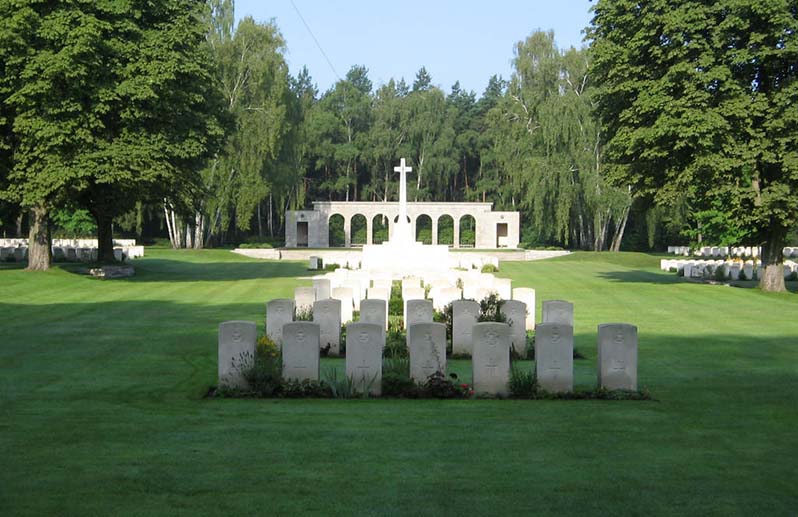
Berlin 1939-1945 War Cemetery
Airmen’s war graves dominate Berlin 1939-1945 War Cemetery.
Some 80% of the nearly 3,600 burials here are of servicemen lost in air raids over Germany’s capital and the towns and cities in the east.
Leipzig was a target of the immense strategic bombing campaign that was Big Week and several hundred Bomber Command servicemen were killed raiding the city.
Those whose remains were recovered were likely buried in individual graves or local churchyards but were later transferred to Berlin.

Durnbach War Cemetery
Nestled in southern Bavaria, Durnbach War Cemetery holds just shy of 3,000 Commonwealth burials.
Like Berlin, the majority are of fallen airmen, shot down on missions over Bavaria, Wurttemberg, Austria, Hessen, and Thuringia.
Around 150 of the burials at Durnbach lost their lives during the events of Big Week and now rest eternally in Southern Germany, although it is likely they were first buried close to where they died and moved to Durnbach after hostilities ended.
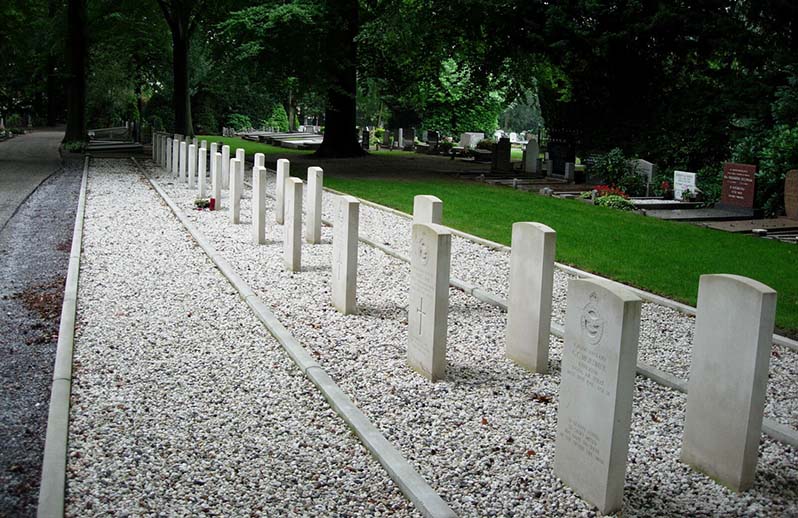
Harderwijk General Cemetery
Harderwijk General Cemetery is one of several Dutch Commonwealth War Graves Cemeteries where you’ll find burials of Big Week.
Flight paths, especially those missions attacking Northern Germany, took Bombers over the Netherlands where they clashed with Luftwaffe aircraft and did their best to dodge flak and anti-aircraft fire.
As the airmen’s war graves at Harderwijk attest, many unlucky bomber crew members did not make it home.
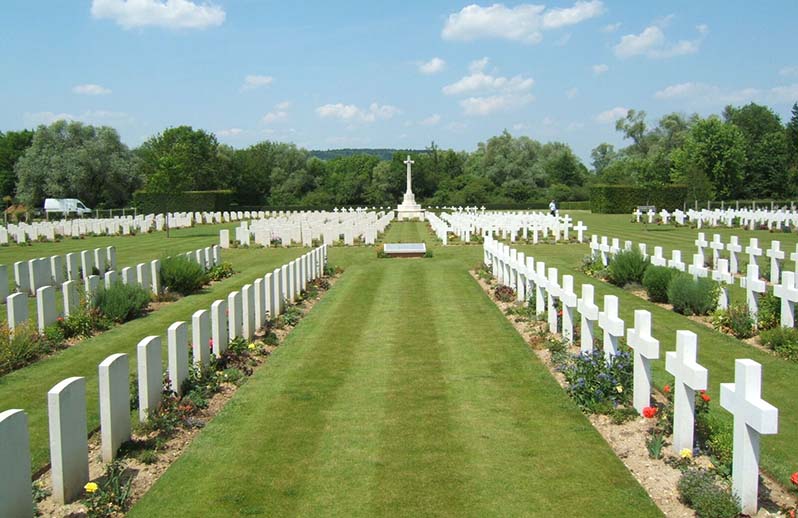
Choloy War Cemetery
Most burials in Choloy War Cemetery are airmen with roughly 20 or so dating from the period of Big Week.
Choloy itself lies within the flight paths of several flight missions, including the RAF’s missions to Stuttgart as part of Big Week, explaining why so many pilots and aircrewmen are buried there.
When opened, Choloy brought in burials from sites where it had become impossible to maintain them to high Commonwealth War Graves standards.

Runnymede Air Forces Memorial
There are those who are simply missing.
Aerial combat’s chaotic and far-ranging nature often means it was often not possible to locate or recover the bodies of fallen airmen who may have been lost deep behind enemy lines.
Others were simply consumed in terrible explosions or crashes and left no earthly remains.
To commemorate all Commonwealth air service personnel lost in operations over the UK and Northwestern Europe during the
Second World War, including the missing of Big Week, the Runnymede Memorial was built.
For over 70 years, Runnymede stands as the permanent point of commemoration for these missing airmen and women, a silent reminder of the cost of operations like Big Week.
What was Big Week?
Big Week, also known as Operation Argument, was a major Allied air offensive fought between 19-26 February 1944.
Operation Argument was aimed at crippling Nazi Germany’s aviation industries using mass heavy bombing.
Aircraft factories and sites that built components, such as ball-bearing production plants, were to be systematically targeted in day and night raids on Germany across one week.
Why did the Allies launch Operation Argument?
As Allied bombing intensified over Europe, the Luftwaffe changed its tactics and developed its aircraft to counter the Allied Air Forces. Losses began to mount, particularly against the USAAF which favoured daytime bombing.
The USAAF had sustained heavy losses in several major raids in early1943 and sought a solution.
The Allies launched the Pointblank directive in June 1943. Pointblank essentially changed the strategic role of the RAF and USAAF’s bombers. Under the directive, the two forces were to concentrate efforts on reducing German fighter production.
As such, Big Week was essentially a culmination of Allied efforts to cripple the Luftwaffe’s ability to fight.
The USAAF primarily ran the operation. It was supported by Royal Air Force and elements of other Commonwealth air forces. These forces undertook large-scale bombing missions as part of Operation Argument.
As the Luftwaffe changed its aircraft and tactics so too did the Allies.
Analysing combat reports, the USAAF realised Allied fighters performed well against their Luftwaffe counterparts but lacked the range to escort heavy bombers deep into Germany.
The Allies introduced P-51 Mustangs equipped with Rolls-Royce Merlin engines as fighter escorts. The P-51s were able to escort the slower bombers deep into Germany itself.
They were also given license to pursue and attack incoming Luftwaffe fighters instead of sticking close to the bombers. The idea was to cripple the Luftwaffe in the air and on the ground.
Allied aircrews had also been gaining experience and numbers in the weeks and months before Big Week.
In late February 1944, Allied air commanders gave the go-ahead to begin Operation Argument.
The RAF’s role in Operation Argument
 Image: A bomber crew boards its Lancaster before the raid on Leipzig (© IWM CH 12210)
Image: A bomber crew boards its Lancaster before the raid on Leipzig (© IWM CH 12210)
Thousands of Commonwealth aircraft and airmen took part in Operation Argument.
RAF missions continued at night time. The crews had been performing night bombing duties since the inception of the strategic bombing campaign and were suited to the task at hand. But even under the cover of night, bombing was costly in men, machinery, and morale.
During Big Week, the RAF worked in tandem with USAAF on bombing specific targets. The RAF may follow a daylight US bombing raid with a night raid of its own, for example, or it may precede a daytime raid with a night mission.
The RAF flew over 2,800 sorties (one aircraft, one pilot, one mission) during the five days of Big Week. During the operation, Bomber Command experimented with new tactics on certain raids to reduce casualties and maximise damage.
19-20 February – Leipzig
The first major RAF action of Big Week was an 820 aircraft raid on Leipzig, but it was not a happy one.
Two diversionary raids, one on the port of Kiel and another smaller one on Berlin, went ahead of the main bomber train intending to draw away German night fighters from Leipzig.
The German air commander sent only a portion of his forces to Kiel and soon his night fighters had picked up the lengthy bomber stream just over the Dutch coast.
As such, the RAF planes were under attack all the way to the target.
Weather conditions had an impact too. Winds were not as forecast and many RAF planes arrived ahead of their target-marking pathfinders. Forced to circle and wait for their targets to be marked, several aircraft were lost to flak and mid-air collisions over Leipzig.
Leipzig itself was covered by cloud. The fast mosquito planes of the Pathfinders, normally ranging ahead of the bomber stream to drop target markers, were forced to use skymarking to designate targets.
While bombing on Leipzig was initially concentrated, it became scattered as the targets moved with the wind.
Including the diversionary raids, around 920 RAF aircraft participated in the Leipzig raid. 79 aircraft were lost, an attrition rate of 8.6%.
Leipzig was the heaviest Bomber Command loss of the war to date. With after-action analysis showing most of the losses had come from Luftwaffe fighters, Leipzig reinforced the idea that Germany’s aviation industry had to be crushed before the Allies fully controlled the sky.
20-21 February – Stuttgart
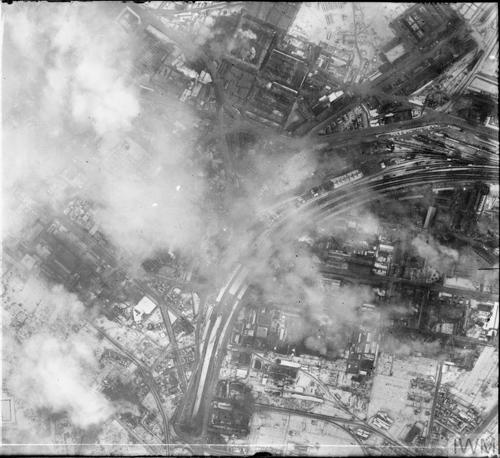 Image: Stuttgart following the RAF raid (Stuttgart © IWM C 4135)
Image: Stuttgart following the RAF raid (Stuttgart © IWM C 4135)
Next up was an attack on Stuttgart.
Stuttgart was home to numerous major industrial companies. Bosch and Daimler-Benz, both intimately involved in aircraft engine production, and SFK ball bearing factories were all located there, making the city a choice target.
Stuttgart was heavily defended by the time of Big Week. Bristling with anti-aircraft weaponry, several structures including the Pragstattel Flakturm flak tower, provided formidable defences. A Luftwaffe fighter squadron was also based at nearby Ectherdingen.
Nearly 600 sorties were flown by the RAF to target Stuttgart. Again, a couple of diversionary raids were flown to draw away the Luftwaffe: a training exercise over the North Sea as a diversion, a small raid on Munich and attacks on Dutch airfields.
The bombers did their job. Stuttgart suffered heavily on the night of the 20 February. Several sites, including the Bosch factory, were heavily damaged.
Compared with Leipzig, the cost was light. RAF losses amounted to 10 aircraft or around 1.5% of the warplanes involved.
21-24 February – Other sorties
Compared with the USAAF’s large-scale daylight raids, the period between 21-24 February 1944 was relatively quiet for the RAF.
Targets included Duisburg, Dusseldorf, and Stuttgart once more, although the intensity of these raids was smaller than the attacks on Leipzig and the large Stuttgart raid.
The RAF also took this opportunity to target V1 and V2 rocket sites, enemy radar installations, and drop mines in the North Sea and Atlantic Coast.
Losses were light with only 1 mine-laying plane lost on the night of 21/22 February.
24-25 February - Schweinfurt
In 1943, the United States Army Air Force flew two disastrous operations over the city, which provided major impetus for the change in bombing strategy and ultimately Big Week.
Factories in and around Schweinfurt produced millions of ball bearings annually. Three of the city’s factories produced a combined 42% of German ball bearing output.
At Schweinfurt, the RAF changed its tactics. The main bomber force was split into two waves of around 390 and 340 aircraft each, flying two hours apart.
Although the losses of the first wave amounted to around 5% of bombers lost, the second wave’s losses were lower at around 1%. Interestingly, after-action reports suggested the second wave was less vulnerable to night fighter attacks.
As had been the case with the other major Big Week RAF operations, a series of diversionary attacks and activities took place. Supporting operations included minelaying in the North Sea and Atlantic, attacks on Kiel and Aachen and strikes on Dutch airfields.
25-26 February – Augsburg
 Image: The damaged MAN factory at Augsburg ( © IWM C 2399)
Image: The damaged MAN factory at Augsburg ( © IWM C 2399)
Bomber Command took the skies for its last Operation Argument raid on the night of 25/26 February. The target, following up a USAAF attack from the previous day, was Augsburg.
Not only was Augsburg located deep within the Nazi Party’s heartland of Bavaria, but it was also an important industrial hub. A Messerschmitt factory was situated in Augsburg and a MAN diesel engine production plant.
Bomber Command flew just over 590 sorties targeting Augsburg and several diversionary operations. The attack, like the Stuttgart raid, was once more split into two waves to maximise damage and lower casualties.
Clear weather and a blanket of snow covering Augsburg meant the Pathfinder’s target indication was unusually precise. As such, the devastation caused by the two bomber waves was substantial.
Augsburg’s magnificent medieval city centre was completely devastated by the RAF’s bombs. With temperatures dropping well below freezing, the city’s firehoses and even the river Lech were frozen.
Blazes broke out across the city. Largely unchecked, they eventually spread to Augsburg’s industrial suburbs, wreaking havoc.
The comparative success of Augsburg showed the RAF that their new tactics were working. Bomber Command lost around 20 aircraft, some 3.6% of the total, on the Augsburg raid.
Was Big Week a success?
The immediate objective of Big Wek and Operation Argument was to cripple or destroy the German aircraft industry. However, a decisive knockout blow didn’t land.
Rather than a single massive victory, Big Week’s effectiveness requires subtler analysis.
For instance, German aircraft production actually increased in the month after Operation Argument, but it was dispersed around the country in hidden plants and facilities at great cost.
Now widely decentralised, Germany’s aviation sector was highly vulnerable to the effects of Allied infrastructure bombing, especially bridges and railways.
Then there was the human cost. While the Allies could rapidly replace their air casualties, the Luftwaffe simply could not. Big Week had cost its fighter arm some 14% of its pilots with 100 German aviators killed. This was a severe blow to Luftwaffe morale and capability.
Germany would also have to bring its fighters deeper into home territory as Allied bombing efforts, and the war on the Eastern Front, intensified. As the pressure on Germany grew stronger, the skies over other parts of Europe were gradually being cleared of the Luftwaffe.
Operation Overlord and the D-Day Landings required complete aerial supremacy. Big Week played an important role in ensuring Allied control over Europe’s skies.
Do you have a story from Big Week? Share it on For Evermore
For Evermore: Stories of the Fallen is our online resource for sharing the memories of the Commonwealth’s war dead.
It’s open to the public to share their family histories and the tales of the service people commemorated by Commonwealth War Graves so that we may preserve their legacies beyond just a name on a headstone or a memorial.
If you have a story of someone we commemorate who died in the sinking of Khedive Ismail, or any of the servicemen and women in our care, we’d love to hear it!
Head to For Evermore to upload and share it for all the world to see.

